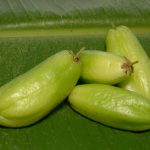
Apples are one of the most popular dessert fruits in the world with a commercial coverage that is global and versatility that makes them ideal for dessert use as well as complementing meats. As well as providing a great sensory experience in both flavour and texture they also contain a raft of health-promoting components which quite rightly led to the saying ‘An apple a day keeps the doctor away’.
From earliest times, apples were known to have certain medicinal benefits and eating them regularly meant that consumers benefited from reduced heart disease (Knekt et al., 1996) and a reduction in a number of cancers (liver, lung, prostate and colon) (Riboli and Norat, 2003).
Research continues to show positive attributes to eating apples for example. An interesting piece of research has shown that eating just two apples a day rather than drinking apple juice can have a positive benefit on reducing blood cholesterol levels (Koutsos et al., 2019).
Apples And Their Antioxidants
With health then in mind, what ‘magic ingredient’ does the apple (Malus x domestica) possess ? Antioxidants always appear to be at the forefront of any answer relating to the ‘health’ componentry in a fruit and those in the apple are no exception (Weichselbaum et al., 2010; Hyson, 2011). Antioxidants are attributed with minimising free radical damage to the cell. Back in 2004 when the USDA assessed the antioxidant levels per serving size in 100 foodstuffs, they found two varieties of apple – the Red Delicious and Granny Smith were ranked 12th and 13th respectively. The main apple antioxidants are a range of polyphenols, some of which are more prevalent in the skins. The componentry are mainly phenolic compounds, the hydroxycinnamic acids, flavonols, procyanidins and dihydrochalcones which are present in apple flesh and peel skins. The anthocyanins are concentrated in the apple peel (Wojdylo et al., 2008; Ceymann et al., 2012).
Apples And Their Fibre Story
They also have a high pectin content – about 4 grams and pectin is a soluble fibre which lends itself to the dietary fibre story. It seems that eating fruits generally with a high fibre content offers protection against developing Parkinson’s Disease. It is reasoned that fibre along with antioxidants can help reduce the incidence of free-radical damage of the nerve cells. The dopamine- producing nerve cells in particular are believed to be protected by such antioxidants.
What else is fibre good for ? Reducing the symptoms of irritable bowel syndrome and avoiding piles or haemorrhoids. Actually, in the latter case its more about reducing the need to strain as it were simply because stools (not an easy subject to discuss) are passed more easily. Fibre also reduces the incidence of producing gall stones and likewise inducing a feeling of being full (a satiety benefit) and even helping with weight loss programmes. Whilst fibre can be found in a number of sources, not all are likely to be as palatable as an apple a day. The other great benefit of soluble fibre in particular is it can help in blood sugar management with those suffering Type 2 diabetes. It’s a low GI effect really.
Generally fruits have been implicated in the ‘detox’ effect on the liver which is presumably because they don’t have fat or other metabolites which the liver needs to readily deal with. The polyphenol quercetin which is found in red apple skins (always eat the skin if possible) apparently helps to support the immune system. Those flavonoids in the flesh and skin such as phloretin and phloridzin for example have potential in controlling blood sugar levels through their action on glucose transporters whilst others are also claimed to minimise tumour growth (Li et al., 2012) as found in a variety of animal studies. Good, high quality human studies are needed to confirm such findings.
Diabetes
Apples have a role to play here in ameliorating the deleterious effects of diabetes. Diet is one of the main approaches to treating diabetes. We’ve already mentioned the benefits of fibre intake and none more so than with diabetes. A significant conclusion from studies over the years is the favourable effect of a high dietary fibre intake, which improves tolerance to carbohydrates and ensures a better metabolic control of diabetes.
In 1983, a study reported on the benefits of various carbohydrates from a number of sources including apples in ameliorating the spiking in plasma blood glucose levels (Ionescu-Tirgoviste et al., 1983).
Back in 2013, a population study looked at people who replaced three servings of fruit juice on a weekly basis with the equivalent amount of whole fruit. This included apples in that diet. Those people who ate the whole fruit were claimed to reduce their risk of developing type-2 diabetes by 7% (Muraki et al., 2013).
Apples And Heart Health
- If you eat two whole apples daily rather than the equivalent apple juice drink in terms of calorie content and sugar content, you can significantly alter markers for poor heart health.
New research has shown that eating just two apples daily can reduce blood cholesterol levels and also reduce the risk of heart disease.
The paper published in the American Journal of Clinical Nutrition was written by researchers from the High Sinclair Unit of Human Nutrition at the University of Reading collaborating with the Fondazione Edmund Mach Institute in Italy (Koutsos et al., 2019). They found that apples which are rich in both fibre and polyphenols reduced the amount of LDL cholesterol and improved a set of markers associated with blood vessel health. All the subjects had slightly raised blood cholesterol levels.
The variety of apples used were Renetta Canada apples that were grown in the Italian area of Trentino which is right up in the far north of the country. These are particularly good varieties for their richness of polyphenols called proanthocyanidins. They compared the apples with apple juice in the diet.
Both foods given to the subjects has the same calorie and sugar content. the apples though had significantly higher amounts of fibre. The fibre content in these apples was 8.5 grams compared to just 0.5 grams. The total polyphenol content was 990mg rather than just 2.5mg.
The study was a randomised controlled trial with 40 women and men between the ages of 29 and 69. They all had moderately elevated levels of cholesterol in their blood. All participants were conditioned over two weeks before any further dietary intervention by ensuring they did not eat probiotics, prebiotics, apples, apple juice or any other apple-containing foods. Over the period of the study, (20 weeks) the subjects avoided all these foods save for the apples or apple juice. They could not eat any apple core !
In the study period, one group ate just two apples with their meals for eight weeks followed by a four-week washout period. After that they drank 500mL of a calorie matched apple juice drink for the remaining eight weeks. The order was reversed for the 2nd group of subjects.
The consumption of two apples daily appeared to reduce those markers associated with cardiovascular disease by 4 per cent. The apples though had no effect on blood pressure (hypertension) or any other CVD markers.
The researchers were clear that a small change in diet could have dramatic and important benefits in improving health.
So then, the apple, eating it as a great way to improving health.
References
Ceymann, M., Arrigoni, E., Scharer, H., Nising, A.B. & Hurrell, R.F. (2012). Identification of apples rich in health-promoting flavan-3-ols and phenolic acids by measuring the polyphenols profile. J. Food Composition & Analysis, 26, pp. 128–135 (Article)
Hyson, D.A. (2011). A comprehensive review of apples and apple components and their relationship to human health. Amer. Soc. of Nutrition, 2, pp. 408–420.
Ionescu-Tîrgovişte, C., Popa, E., Sintu, E., Mihalache, N., Cheţa, D., & Mincu, I. (1983). Blood glucose and plasma insulin responses to various carbohydrates in type 2 (non-insulin-dependent) diabetes. Diabetologia, 24(2), pp. 80-84 (Article).
Knekt, P., Jarvinen, R., Reunanen, A., & Maatela, J. (1996). Flavonoid intake and coronary mortality in Finland: A cohort study. British Medical J., 312, pp. 478–481 (Article).
Koutsos, A., Riccadonna, S., Ulaszewska, M.M., Franceschi, P., Trošt, K., Galvin, A., Braune, T., Fava, F., Perenzoni, D., Mattivi, F., Tuohy, K.M., Lovegrove, J.A. (2019) Two apples a day lower serum cholesterol and improve cardiometabolic biomarkers in mildly hypercholesterolemic adults: a randomized, controlled, crossover trial, The American Journal of Clinical Nutrition, , nqz282. (Article)
Li, Y., Mei, L., Niu, Y. et al. (2012). Low molecular weight apple polysaccharides induced cell cycle arrest in colorectal tumor. Nutr. Cancer, 64, pp. 439–463.
Muraki, I., Imamura, F., Manson, J. E., Hu, F. B., Willett, W. C., van Dam, R. M., & Sun, Q. (2013). Fruit consumption and risk of type 2 diabetes: results from three prospective longitudinal cohort studies. BMJ (Clinical research ed.), 347, f5001. (Article) https://doi.org/10.1136/bmj.f5001 including the corrected paper: Fruit consumption and risk of type 2 diabetes: results from three prospective longitudinal cohort studies. BMJ. 2013;347:f6935. Published 2013 Dec 4. (Article) doi:10.1136/bmj.f6935 .
Riboli, E., & Norat, T. (2003). Epidemiologic evidence of the protective effect of fruit and vegetables on cancer risk. Amer. J. Clin. Nutr, 78, pp. 559S–569S (Article).
Weichselbaum, E., Wyness, L. & Stanner, S. (2010). Apple polyphenols and cardiovascular disease- a review of the evidence. Nutrition Bulletin, 35, pp. 92–101.
Wojdylo, A., Oszmianski, J. & Laskowski, P. (2008). Polyphenolic compounds and antioxidant activity of new and old apple varieties. J. Agric. Food Chem., 56, pp. 6520–6530.
17th February 2019 revised from an item written for FoodWrite Ltd 23rd March 2014. Revised 17th December 2019 to include material from the apple consumption study by University of Reading & reported in the AJCN.



I have eaten an apple every day since I was 21 and I am now 65. Must admit it has done me the world of good. You know what they say about one a day keeps the doctor away well it certainly seems to do it for me. Mind you I have had cancer and a hysterectomy but you know you cant have everything as healthy as you would like.
Interesting article. Thank you. Are the health benefits that the research suggests only relevant to uncooked apples? I eat a lot of the cooked variety!
Hi Jon,
Just a really great question and thanks for your comment! This article concerns the benefits of consuming raw (uncooked) apples. Your question prompted me to think further about the cooking of apples in particular as we too eat plenty of stewed fruit for dessert. Looking at the research and based on work I did years ago on blackcurrants, cooking fruit certainly has an impact which is both beneficial and sometimes not as beneficial.
The consensus view is that cooked apples are good for you but whether it is better than the uncooked version depends on your nutritional requirements. A check through both the research literature and on other reputable web-sites certainly considers cooked apples to be good for gut health in particular.
The main benefits are that it makes pectin in the fruit flesh more accessible to digestion. In other words there is an increase in soluble dietary fibre because it is released from the pulp cell walls. The downside to stewing etc. is that we remove the peels which contain plenty of fibre too as well as other ‘good’ nutrients. Soluble dietary fibre though is extremely useful not just for gut movement but also as a food (prebiotic) for all our gut flora and fauna.
One of the downsides is a general reduction in the level of vitamins especially vitamin C and various B types which happens with all cooking. These vitamins though are still present in the cooked fruit and will still have some nutritional benefit. The amount left depends on how long the cooking process is.
The other upside is a release of beneficial nutrients and antioxidants not just from the pulp but also from the seeds if they are kept in and then discarded afterwards. Some chefs leave the skins on so that one antixoxidant, quercetin is retained in the cook.
To avoid me being too long winded, there are plenty of health benefits to cooking your apples. I will write an article on the benefits of cooking this fruit in particular because it is an extremely interesting topic. Thanks for the question!